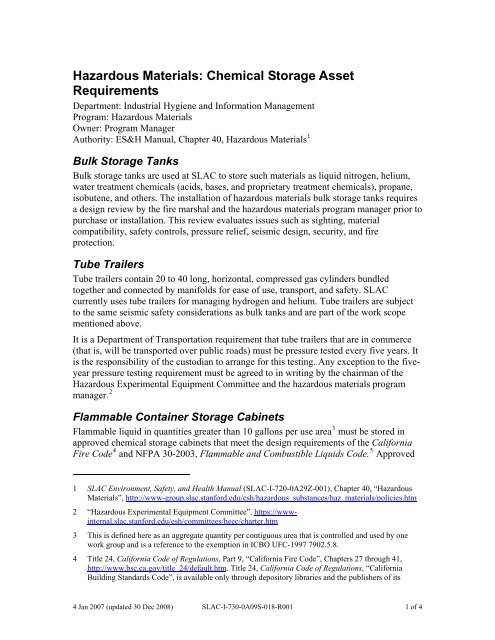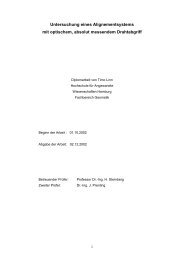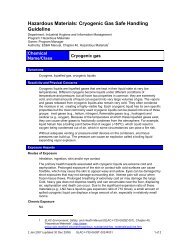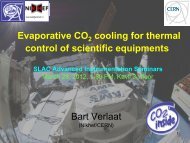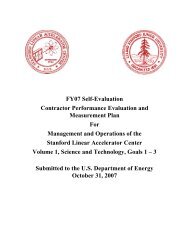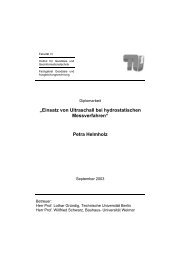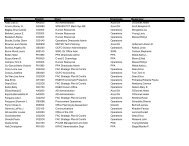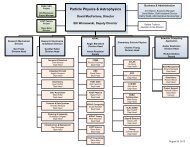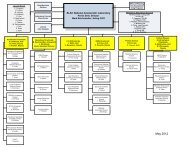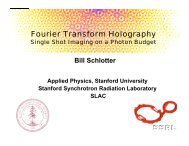Hazardous Materials: Chemical Storage Asset Requirements
Hazardous Materials: Chemical Storage Asset Requirements
Hazardous Materials: Chemical Storage Asset Requirements
Create successful ePaper yourself
Turn your PDF publications into a flip-book with our unique Google optimized e-Paper software.
<strong>Hazardous</strong> <strong>Materials</strong>: <strong>Chemical</strong> <strong>Storage</strong> <strong>Asset</strong><br />
<strong>Requirements</strong><br />
Department: Industrial Hygiene and Information Management<br />
Program: <strong>Hazardous</strong> <strong>Materials</strong><br />
Owner: Program Manager<br />
Authority: ES&H Manual, Chapter 40, <strong>Hazardous</strong> <strong>Materials</strong> 1<br />
Bulk <strong>Storage</strong> Tanks<br />
Bulk storage tanks are used at SLAC to store such materials as liquid nitrogen, helium,<br />
water treatment chemicals (acids, bases, and proprietary treatment chemicals), propane,<br />
isobutene, and others. The installation of hazardous materials bulk storage tanks requires<br />
a design review by the fire marshal and the hazardous materials program manager prior to<br />
purchase or installation. This review evaluates issues such as sighting, material<br />
compatibility, safety controls, pressure relief, seismic design, security, and fire<br />
protection.<br />
Tube Trailers<br />
Tube trailers contain 20 to 40 long, horizontal, compressed gas cylinders bundled<br />
together and connected by manifolds for ease of use, transport, and safety. SLAC<br />
currently uses tube trailers for managing hydrogen and helium. Tube trailers are subject<br />
to the same seismic safety considerations as bulk tanks and are part of the work scope<br />
mentioned above.<br />
It is a Department of Transportation requirement that tube trailers that are in commerce<br />
(that is, will be transported over public roads) must be pressure tested every five years. It<br />
is the responsibility of the custodian to arrange for this testing. Any exception to the fiveyear<br />
pressure testing requirement must be agreed to in writing by the chairman of the<br />
<strong>Hazardous</strong> Experimental Equipment Committee and the hazardous materials program<br />
manager. 2<br />
Flammable Container <strong>Storage</strong> Cabinets<br />
Flammable liquid in quantities greater than 10 gallons per use area 3 must be stored in<br />
approved chemical storage cabinets that meet the design requirements of the California<br />
Fire Code 4 and NFPA 30-2003, Flammable and Combustible Liquids Code. 5 Approved<br />
1 SLAC Environment, Safety, and Health Manual (SLAC-I-720-0A29Z-001), Chapter 40, “<strong>Hazardous</strong><br />
<strong>Materials</strong>”, http://www-group.slac.stanford.edu/esh/hazardous_substances/haz_materials/policies.htm<br />
2 “<strong>Hazardous</strong> Experimental Equipment Committee”, https://wwwinternal.slac.stanford.edu/esh/committees/heec/charter.htm<br />
3 This is defined here as an aggregate quantity per contiguous area that is controlled and used by one<br />
work group and is a reference to the exemption in ICBO UFC-1997 7902.5.8.<br />
4 Title 24, California Code of Regulations, Part 9, “California Fire Code”, Chapters 27 through 41,<br />
http://www.bsc.ca.gov/title_24/default.htm. Title 24, California Code of Regulations, “California<br />
Building Standards Code”, is available only through depository libraries and the publishers of its<br />
4 Jan 2007 (updated 30 Dec 2008) SLAC-I-730-0A09S-018-R001 1 of 4
<strong>Hazardous</strong> <strong>Materials</strong>: <strong>Chemical</strong> <strong>Storage</strong> <strong>Asset</strong> <strong>Requirements</strong><br />
and rated hazardous materials storage cabinets will not be used for ordinary (nonhazardous)<br />
storage. Cabinets used to store flammable liquids must meet the following<br />
specifications:<br />
The combined total of all liquids will not exceed 120 gallons (454 L).<br />
Cabinets used to store flammable liquids must be provided with a conspicuous label<br />
in red letters on contrasting background which reads FLAMMABLE–KEEP FIRE<br />
AWAY.<br />
Doors must be well fitted and equipped with a latch and new cabinets must be selfclosing.<br />
Cabinets must be seismically braced to a sound structure to prevent dislodgement<br />
during an earthquake. The seismic bracing must not penetrate the cabinet in such a<br />
way that it would facilitate release of the chemical from the cabinet. The SLAC fire<br />
marshal approves seismic bracing of chemical cabinets.<br />
The bottom of the cabinet will be liquid tight to a height of at least two inches (50.8<br />
mm).<br />
Cabinets must be constructed of metal and must be listed (by an accredited listing<br />
agency).<br />
The cabinet, including the door, must be double walled with 1.5 inch (38.1 mm)<br />
airspace between the walls.<br />
Joints must be riveted or welded and tight-fitting.<br />
Unlisted cabinets can be used if approved by the SLAC fire marshal and they<br />
Are constructed from steel with a thickness of at least 0.044 inch (1.12 mm) (18<br />
gauge)<br />
Meet all the requirements of a listed cabinet<br />
Combustible material (wood shelves added after the fact, cardboard boxes and paper)<br />
should be minimized or eliminated.<br />
The number of flammable liquid storage cabinets and quantity of flammable materials<br />
allowed in a building is regulated and determined by occupancy codes, space between<br />
cabinets, and if the building is sprinklered. Contact the SLAC fire marshal for details.<br />
Corrosive Material <strong>Storage</strong> Cabinets<br />
Incompatible corrosives must not be stored in the same cabinet. All corrosive storage<br />
cabinets must be conspicuously labeled (letters on contrasting background) with<br />
CORROSIVE – ACID or CORROSIVE – BASE, and seismically braced without<br />
penetrating the cabinet in such a way that would facilitate release of the contents during<br />
an earthquake. All seismic bracing must be approved by the SLAC fire marshal. Cabinets<br />
must be listed by an accredited listing agency for the intended storage of corrosives, or<br />
meet the following requirements:<br />
various components. See the “SLAC Research Library Community Pages”, http://wwwgroup.slac.stanford.edu/library/CommunityPages.asp,<br />
for available standards. A hard copy of the 2007<br />
California Fire Code is available; see<br />
http://www.slac.stanford.edu/spires/find/books/www?key=352675.<br />
5 National Fire Protection Association (NFPA), Flammable and Combustible Liquids Code (NFPA 30-<br />
2003). See the “SLAC Research Library Community Pages”, http://wwwgroup.slac.stanford.edu/library/CommunityPages.asp,<br />
for available standards.<br />
4 Jan 2007 (updated 30 Dec 2008) SLAC-I-730-0A09S-018-R001 2 of 4
<strong>Hazardous</strong> <strong>Materials</strong>: <strong>Chemical</strong> <strong>Storage</strong> <strong>Asset</strong> <strong>Requirements</strong><br />
The bottom of the cabinet must be liquid tight to a height of at least two inches.<br />
Cabinets will be constructed from steel with a thickness of at least 0.044 inch (1.12<br />
mm) (18 gauge).<br />
Cabinets, including the door, must be double walled with 1.5-inch air space between<br />
the walls.<br />
Joints must be riveted or welded and tight-fitting.<br />
Doors must be well fitted, self-closing, and equipped with a self-latching device.<br />
Cabinets must be treated or coated on the interior with a material that is non-reactive<br />
with the hazardous material stored, and this treatment or coating must cover the entire<br />
interior of the cabinet.<br />
The quantity of corrosive materials allowed in a building is regulated and determined<br />
by occupancy codes, space between cabinets, and if the building is sprinklered.<br />
Contact the SLAC fire marshal for details.<br />
Laboratory Hoods with Built-in <strong>Storage</strong> Cabinets<br />
Built-in flammable liquid and corrosive material storage cabinets in laboratory hoods are<br />
subject to the requirements listed above.<br />
Note For requirements regarding electrical equipment and devices within cabinets<br />
used for the storage of hazardous materials, see the National Electrical Code. 6<br />
<strong>Chemical</strong> Refrigerators<br />
Ordinary domestic refrigerators and freezers must not be used for storing flammable<br />
liquids due to exposure to electrical components (light bulbs, switches, contacts and<br />
motors) that can become potential ignition sources. These ignition sources may initiate a<br />
fire or an explosion if flammable vapors are present. Refrigerators and freezers for<br />
storing flammable liquids and/or temperature sensitive chemicals such as peroxides or<br />
epoxies must be designed, constructed and approved for that purpose. Domestic<br />
refrigerator/freezers as well as units that have been modified to remove spark sources are<br />
not acceptable.<br />
Refrigerators must be labeled on the exterior: CAUTION – FOR CHEMICAL<br />
STORAGE ONLY; DO NOT STORE FOOD OR BEVERAGES IN THIS<br />
REFRIGERATOR. Labels may be fabricated by users provided the labels are legible<br />
and securely affixed to the refrigerator.<br />
The custodian must have a means (manual or automated) to document the storage<br />
temperature of the temperature-sensitive materials.<br />
Refrigerators used for food storage in or near work areas (shops and labs) must be<br />
labeled with words to the effect of: NOTICE – FOOD MAY BE STORED IN THIS<br />
REFRIGERATOR. DO NOT STORE CHEMICALS. Refrigerators used for food and<br />
beverage storage that are located in lunch rooms and office buildings, where there is<br />
no shop or laboratory type chemical use, do not require any postings.<br />
6 National Fire Protection Association (NFPA), National Electrical Code (NFPA 70-2005) See the<br />
“SLAC Research Library Community Pages”, http://wwwgroup.slac.stanford.edu/library/CommunityPages.asp,<br />
for available standards. A hard copy of NFPA<br />
70-2005 is available; see http://www.slac.stanford.edu/spires/find/books/www?key=327328.<br />
4 Jan 2007 (updated 30 Dec 2008) SLAC-I-730-0A09S-018-R001 3 of 4
<strong>Hazardous</strong> <strong>Materials</strong>: <strong>Chemical</strong> <strong>Storage</strong> <strong>Asset</strong> <strong>Requirements</strong><br />
Other <strong>Storage</strong> Cabinets<br />
It is SLAC policy to allow storage of small quantities of non-flammable, non-highly<br />
hazardous materials in other storage cabinets if present in quantities below the exempt<br />
limits for that chemical class as provided by the California Fire Code, provided the<br />
following conditions are met: 7<br />
The cabinet is clearly identified through exterior labeling as containing chemicals.<br />
The total quantity of chemicals stored in this fashion per cabinet is less than five<br />
gallons.<br />
The cabinet is shown on the CMS map. 8<br />
The cabinet is included in the custodian monthly inspections.<br />
Gas Racks and Compressed Gas Cylinder <strong>Storage</strong><br />
At SLAC, gas cylinders are managed in one of two ways: as individual cylinders or as<br />
groups of gas cylinders known as six-packs (six individual cylinders managed as a<br />
unit and connected by manifold). See Chapter 38, “Compressed Gas Cylinders”, 9 for<br />
more information.<br />
7 See note 4<br />
8 “<strong>Chemical</strong> Use Maps”, http://www-group.slac.stanford.edu/esh/groups/cgs/hmaq/cms/ (System<br />
Links><strong>Chemical</strong> Use Maps)<br />
9 SLAC Environment, Safety, and Health Manual (SLAC-I-720-0A29Z-001), Chapter 38, “Compressed<br />
Gas Cylinders”, http://wwwgroup.slac.stanford.edu/esh/hazardous_substances/compressed_gases/policies.htm<br />
4 Jan 2007 (updated 30 Dec 2008) SLAC-I-730-0A09S-018-R001 4 of 4


